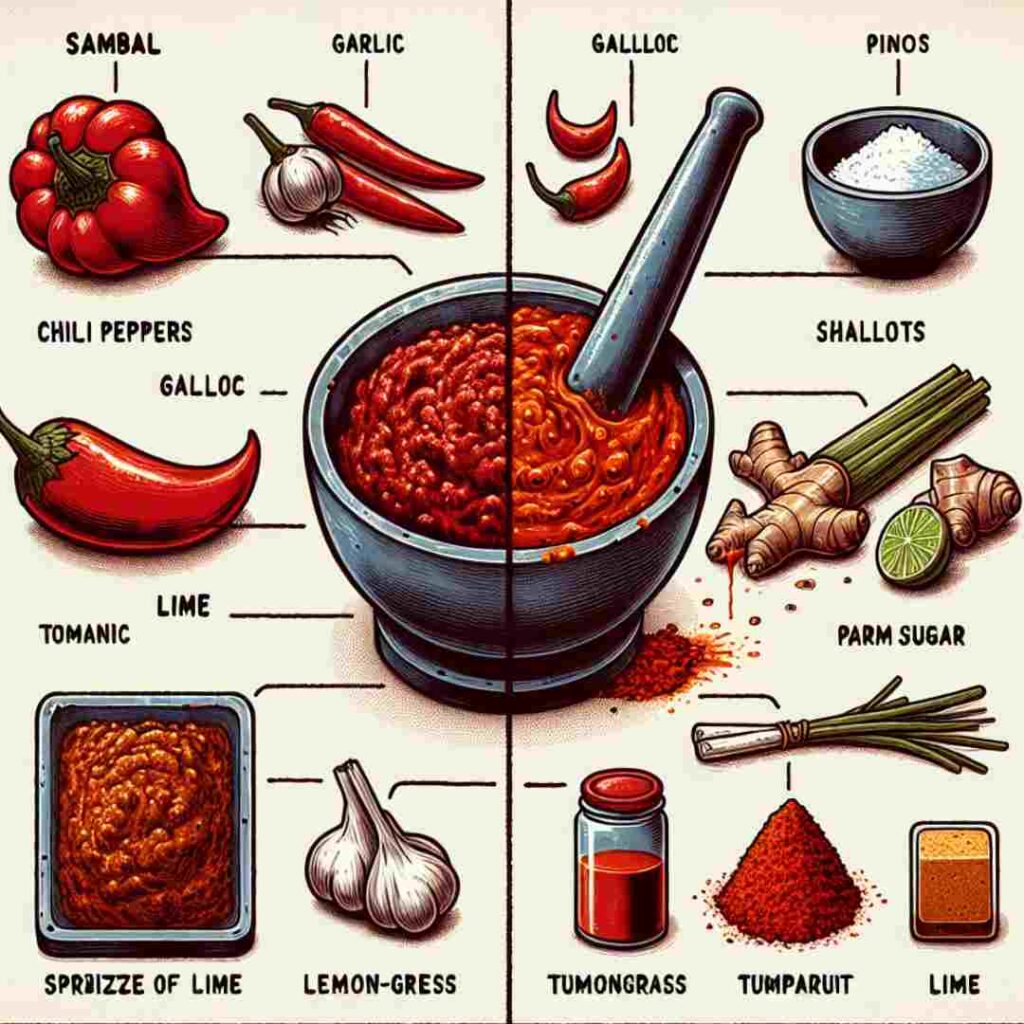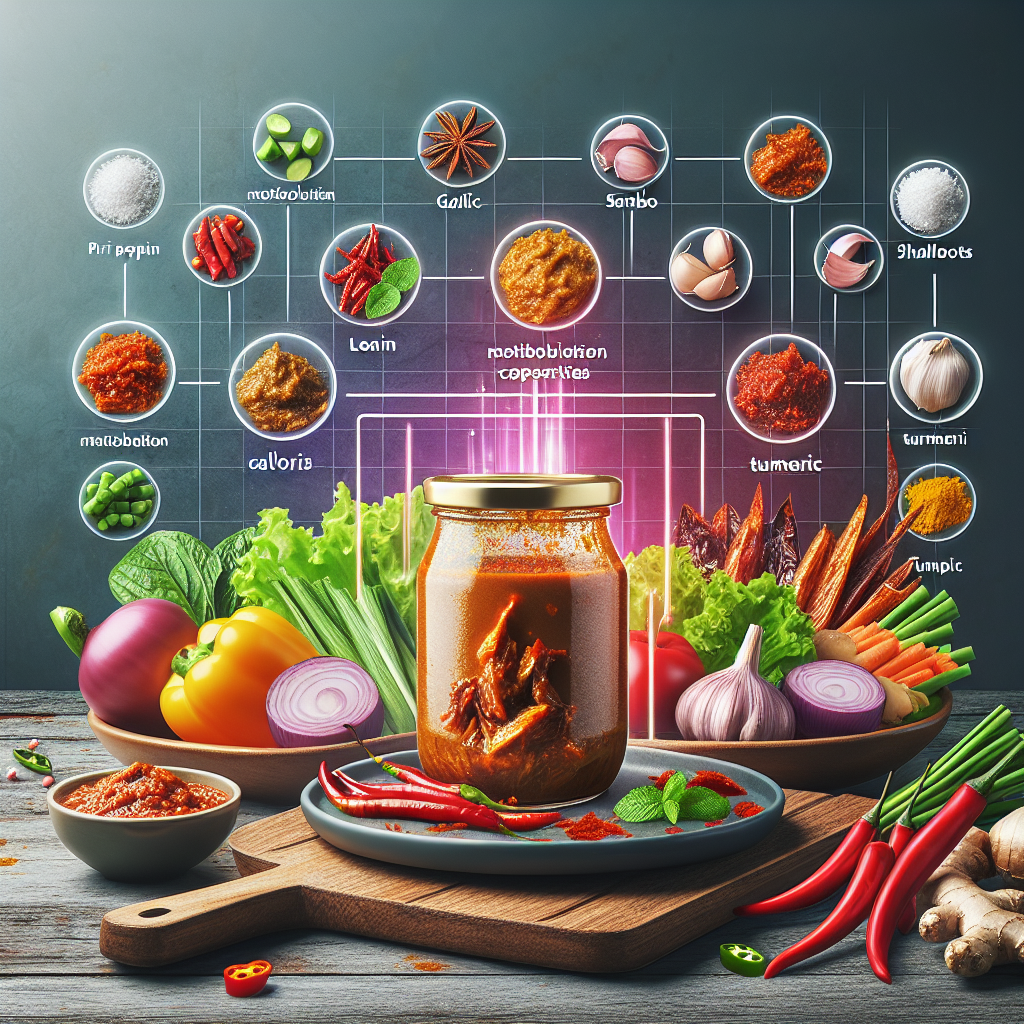Imagine wandering through an Indonesian market filled with intoxicating aromas of spices and sizzling street food. Two culinary stars of the region—Sambal and Rendang Paste—stand out, each boasting a rich tapestry of flavors and history. For food enthusiasts, home cooks, and lovers of Indonesian cuisine, understanding these two staples can elevate your cooking game to new heights. In this blog post, we’ll explore the unique attributes of Sambal and Rendang Paste, helping you appreciate and incorporate these flavors into your kitchen.
Introduction to Indonesian Flavors
Indonesia, an archipelago of diverse cultures and flavors, is renowned for its vibrant culinary scene. Central to this are Sambal and Rendang Paste, two iconic condiments that showcase Indonesia’s rich spice heritage. These ingredients offer home cooks and food lovers a gateway to authentic Indonesian cuisine.
While Sambal and Rendang Paste are rooted in tradition, they serve different purposes in the kitchen. Sambal is a versatile, spicy condiment made from chili peppers and various seasonings, used to add heat and flavor to dishes. On the other hand, Rendang Paste forms the backbone of rendang—a slow-cooked beef dish with complex layers of spices.
Let’s unravel the distinct characteristics, uses, and flavor profiles of Sambal and Rendang Paste so you can bring a taste of Indonesia to your meals.
The Origins of Sambal

Sambal has been a staple in Indonesian households for centuries. Its origins trace back to the indigenous people of Indonesia, who used local ingredients to create fiery condiments. Over time, Sambal has evolved, incorporating various regional flavors and ingredients.
Today, Sambal is an integral part of Indonesian cuisine, with hundreds of variations across the archipelago. Common ingredients include chili peppers, garlic, shallots, and shrimp paste. Each variation offers a unique taste, ranging from sweet and tangy to intensely spicy.
For home cooks, Sambal provides an easy way to add heat and flavor to various dishes. Whether spooned over rice, mixed into noodles, or used as a dipping sauce, Sambal is a versatile kitchen companion.
The Rich History of Rendang Paste
Rendang Paste is the crucial ingredient in rendang, a dish that hails from the Minangkabau ethnic group of West Sumatra. Traditionally, rendang was prepared for ceremonial occasions, slowly cooked over low heat until the flavors melded together perfectly.
The dish’s distinctive taste comes from the Rendang Paste, a blend of spices including ginger, galangal, lemongrass, and turmeric. This combination imparts a warm, aromatic, savory, and sweet flavor.
Preparing rendang is a labor of love, often taking several hours to achieve the rich, tender texture that is characteristic of the dish. For Indonesian cuisine enthusiasts, mastering rendang is a rewarding culinary experience.
Comparing the Ingredients

Both Sambal and Rendang Paste start with a foundation of aromatic ingredients, but their flavor profiles diverge significantly. Sambal typically features a base of chili peppers, garlic, and shallots, with variations incorporating tomatoes, lime juice, or palm sugar.
Rendang Paste, on the other hand, relies on a more complex blend of spices. Key ingredients include ginger, galangal, lemongrass, and turmeric, creating a rich and earthy flavor profile. Coconut milk is often added during cooking to enhance the dish’s creaminess.
Understanding these differences is crucial for home cooks to use each ingredient effectively. Sambal is ideal for adding heat and brightness, while Rendang Paste provides depth and warmth.
Flavor Profiles Unleashed
The flavor profiles of Sambal and Rendang Paste are as distinct as they are captivating. Sambal is known for its bold heat, derived from chili peppers, balanced by the savory notes of garlic and shallots. It can also offer hints of sweetness or tanginess, depending on the variety.
In contrast, Rendang Paste presents a complex symphony of spices with earthy, warm flavors at the forefront. Including coconut milk adds a creamy richness that complements the robust spice blend.
Experimenting with these flavors can lead to exciting culinary discoveries for food enthusiasts. Sambal’s fiery kick can enliven simple dishes, while Rendang Paste’s intricate layers elevate more elaborate creations.
Culinary Uses of Sambal

Sambal’s versatility makes it a beloved ingredient in kitchens around the world. Its fiery heat and bold flavors make it an excellent addition to various dishes. Here are a few ways to incorporate Sambal into your cooking:
Condiment: Use Sambal for grilled meats, seafood, or vegetables. Its spicy kick can enhance the flavors of any dish.
Marinade: Mix Sambal with soy sauce, lime juice, and ginger to create a flavorful marinade for chicken or tofu.
Stir-Fries: Add a spoonful of Sambal to your favorite stir-fry recipes for extra heat and flavor.
For home cooks seeking new flavor experiences, Sambal is an essential pantry staple.
Culinary Uses of Rendang Paste
Rendang Paste is the foundation of rendang, but its uses extend beyond this iconic dish. Its rich, aromatic flavors can add depth to a variety of recipes. Here are a few ways to use Rendang Paste in your cooking:
- Curries: Incorporate Rendang Paste into coconut-based curries for a complex, aromatic flavor.
- Soups: Add a dollop of Rendang Paste to soups and stews for an exotic twist.
- Noodle Dishes: Enhance noodle dishes with a spoonful of Rendang Paste, bringing warmth and depth to your meals.
For Indonesian cuisine lovers, Rendang Paste offers endless possibilities for culinary exploration.
Health Benefits and Considerations

Both Sambal and Rendang Paste offer health benefits, thanks to their use of fresh herbs and spices. Chili peppers, a primary ingredient in Sambal, contain capsaicin, known for its metabolism-boosting properties. Garlic and shallots contribute antioxidants and anti-inflammatory benefits.
Rendang Paste’s ingredients, such as ginger and turmeric, are celebrated for their anti-inflammatory and immune-boosting properties. However, it’s essential to be mindful of portion sizes, as Sambal and Rendang Paste can be high in sodium and calories.
For health-conscious cooks, balancing these ingredients with fresh vegetables and lean proteins can create nutritious, flavorful meals.
Sambal vs. Rendang Paste: Which to Choose
Choosing between Sambal and Rendang Paste depends on your culinary goals and flavor preferences. If you’re seeking a quick, versatile way to add heat to dishes, Sambal is the way to go. Its simplicity and adaptability make it a go-to condiment for many home cooks.
On the other hand, if you’re ready to undertake a culinary adventure, Rendang Paste is an excellent choice. Its rich blend of spices offers a depth of flavor that can transform your cooking.
Ultimately, both ingredients have their place in the kitchen. Experimenting with Sambal and Rendang Paste can lead to delightful new flavor combinations.
Tips for Making Your Own Sambal
Making Sambal from scratch is a rewarding experience for home cooks. Here’s a simple recipe to get you started:
Ingredients:
- 10-15 red chili peppers
- Three cloves garlic
- Two shallots
- One tablespoon shrimp paste
- One tablespoon of lime juice
- One teaspoon sugar
- Salt to taste
Instructions:
- Blend the chili peppers, garlic, shallots, and shrimp paste until smooth.
- Heat a small amount of oil in a pan and sauté the blended mixture until fragrant.
- Add lime juice, sugar, and salt, and cook for a few minutes.
For a personalized touch, adjust the ingredients to suit your taste preferences. Homemade Sambal can be stored in the refrigerator for up to two weeks.
Tips for Making Your Rendang Paste
Creating your own Rendang Paste allows you to customize the flavors. Here’s a basic recipe to try:
Ingredients:
- 2 inches ginger
- 2 inches galangal
- Three lemongrass stalks
- Four shallots
- Five cloves garlic
- One teaspoon turmeric
- One tablespoon coriander seeds
- One tablespoon of cumin seeds
- Two red chilies
- 1 cup coconut milk
- Salt to taste
Instructions:
- Blend all ingredients except coconut milk until smooth.
- Heat a small amount of oil in a pan and sauté the paste until fragrant.
- Add coconut milk and simmer until the mixture thickens.
Rendang Paste can be stored in the refrigerator for up to a month. Use it to infuse your dishes with rich, aromatic flavors.
Sambal and Rendang Paste in Global Cuisine
While Sambal and Rendang Paste have roots in Indonesian cuisine, their flavors have transcended borders. Chefs and home cooks worldwide have embraced these ingredients, incorporating them into diverse dishes.
Sambal is a popular condiment for grilled meats and seafood in Southeast Asia. It has found its way into burgers, tacos, and pizzas in the West, adding a spicy kick to familiar favorites.
With its complex spice blend, Rendang Paste has inspired chefs to create fusion dishes that blend Indonesian flavors with international cuisines. Its use in curries, stews, and noodle dishes highlights its versatility.
For food enthusiasts, exploring how these ingredients are used globally can inspire new culinary creations.
Conclusion The Best of Both Worlds
Sambal and Rendang Paste are culinary treasures that offer a glimpse into the rich tapestry of Indonesian cuisine. Whether a seasoned chef or a home cook, these ingredients can elevate your dishes with bold flavors and aromatic spices.
Sambal’s versatility and heat make it a go-to choice for adding zest to any meal, while Rendang Paste’s depth and warmth offer a satisfying culinary challenge. Understanding each’s unique characteristics allows you to bring the best of both worlds into your kitchen.
For those eager to explore more, countless resources and recipes are available to guide your culinary adventures. Whether making Sambal from scratch or experimenting with Rendang Paste, these flavors will surely delight your taste buds and expand your culinary horizons.



















